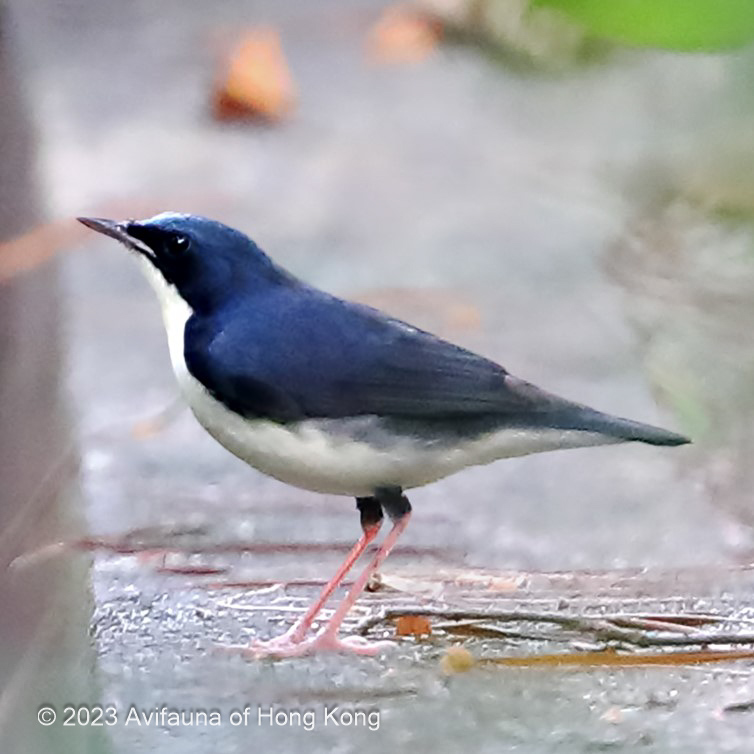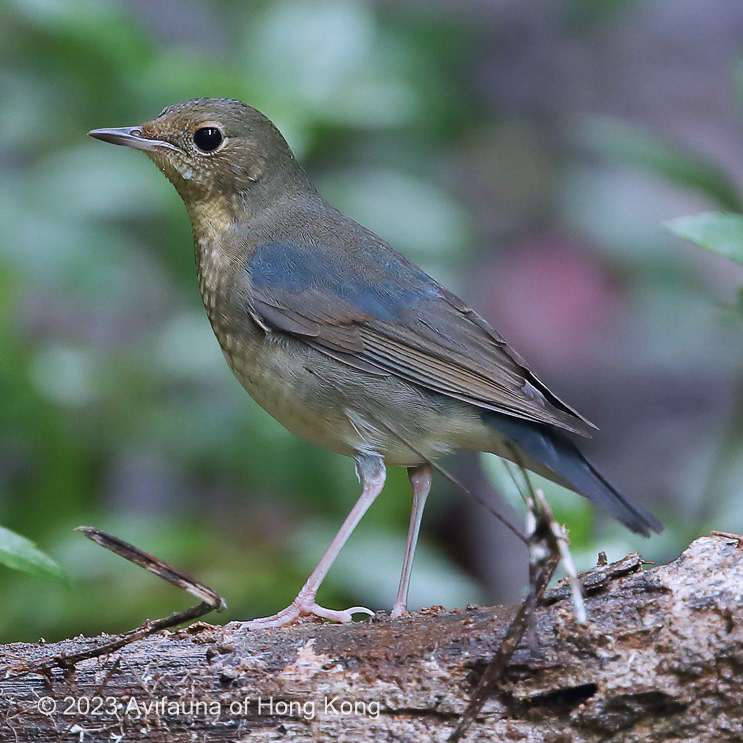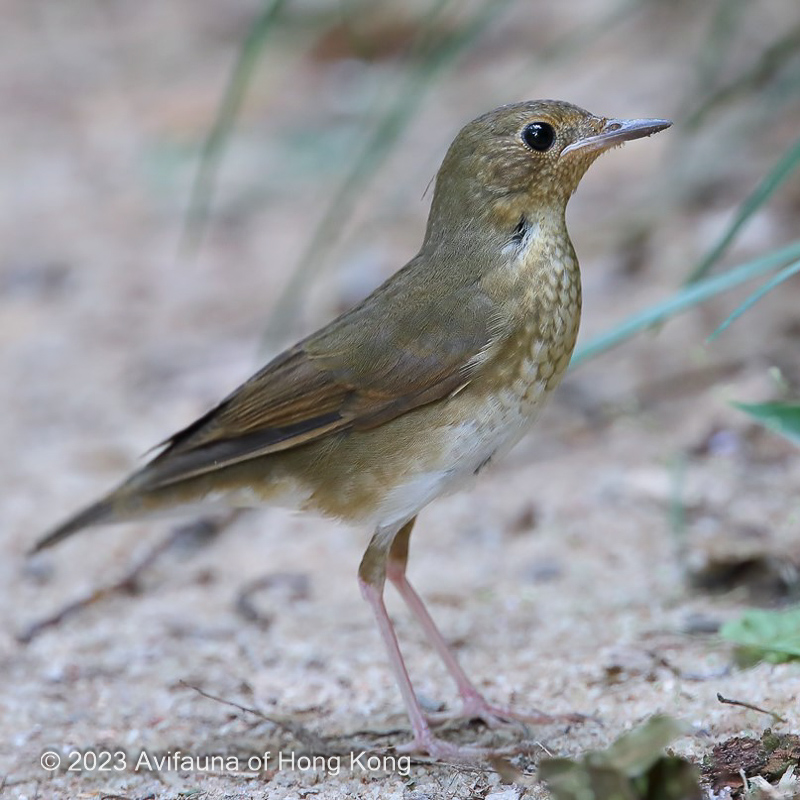Siberian Blue Robin Larvivora cyane 藍歌鴝
Category I. Scarce passage migrant in wooded areas, commoner in autumn than spring.
IDENTIFICATION

Sep. 2021, Michelle and Peter Wong.
13-14-cm. Adult male. Blue upperparts. A dark area on the lores extends down below the eye to the flanks. The underparts are white apart from dark upper flanks and blue-grey lower flanks. Pale pink legs.

|
Oct. 2020, Michelle and Peter Wong. Some adult males are poorly-marked. |

Sep 2020, Michelle and Peter Wong.
First-winter male. Grey-brown upperparts with variable blue on the rump, uppertail-coverts, tail, wing coverts, and scapulars. The throat and breast have a buff wash and show diffuse scaling.

|
Sep. 2019, Michelle and Peter Wong. Adult female. Grey-brown upperparts with a blue wash on the rump, uppertail-coverts and tail. Some also show a hint of blue on the nape and mantle. The breast and flanks are a pale brown; the breast shows diffuse scaling. First-winter female is like the adult female but usually lacks any blue in the plumage. |
VOCALISATIONS
The usual call is a soft ‘tuk’.
DISTRIBUTION & HABITAT PREFERENCE
Siberian Blue Robin occurs regularly in closed-canopy forested areas of the Tai Mo Shan massif and the country parks. It is occasionally trapped at Mai Po and HK Wetland Park and there are frequent reports from Po Toi; it also occurs in urban edge areas in Kowloon (e.g., at Ho Man Tin every autumn from 2016 to 2020).
OCCURRENCE
The first substantiated record of Siberian Blue Robin in HK was in 1985. Since then, it has proved to be a scarce passage migrant that is much less numerous in spring than in autumn.
It has been recorded on spring passage in approximately 50% of the years from 1985 to 2020, with usually only one or two sightings per season; however, five birds were noted in April 2005 and eight in spring 2016. Although extreme dates are 29 March and 29 April, there have only been four March records, with the majority in the first two weeks of April (Figure 1).
Eighty-four percent of records have occurred in autumn between 29 August and 29 October. Main passage occurs from the second week of September to the end of September with a peak in the third week. It is scarce after the first week of October.
Apart from 1995, the estimated number of individuals recorded each autumn until 2013 was in single digits. Since then, with the exception of 2015, all such counts have been in double digits with a high of at least 16 birds in autumn 2016. This is considered due to an increase in observer activity.
Including the first in January 1986 there here have been five winter records from 20 December to 12 February, all involving single birds on one day apart from one at Tai Po Kau on 9th and 11 January 2021.
Birds usually occur singly, although up to three birds may be found at different places in the same general area. The highest single-site count is of four at Ho Man Tin on 19 September 2019.
BEHAVIOUR, FORAGING AND DIET
Shy and elusive. Hops and runs along the ground, frequently shivering its tail, as it forages on the ground in low vegetation and leaf litter for invertebrates. Presence is often detected by its call.
RANGE & SYSTEMATICS
Three races of Siberian Blue Robin are recognised by the IOC, although some authorities question the validity of L. c. bochaiensis (Cramp 1988, Shirihai and Svensson 2018, Wells 2007). Both L. c. cyane and L. c. bochaiensis breed in northeast Asia and migrate through eastern China en route to their wintering grounds in southeast Asia. Presumably, both of these subspecies occur in HK on passage. A third subspecies, L. c. nechaevi, has recently been recognised from east Russia and Japan.
The nominate form breeds from northeast Kazakhstan east to south-central Siberia and north Mongolia, while bochaiensis breeds in eastern Siberia, northeast China (Inner Mongolia and Heilongjiang), Korea and Japan. Wintering Siberian Blue Robins are found in southwest China, southeast Asia, Sumatra, Java and Borneo. The third, nechaevi, breeds on Sakhalin Island, the Kuril Islands and in Japan; its wintering range is unknown (Collar 2020).
CONSERVATION STATUS
IUCN: Least Concern. Population trend decreasing.
Figure 1.

Collar, N. (2020). Siberian Blue Robin (Larvivora cyane), version 1.0. In Birds of the World (J. del Hoyo, A. Elliott, J. Sargatal, D. A. Christie, and E. de Juana, Editors). Cornell Lab of Ornithology, Ithaca, NY, USA. https://doi.org/10.2173/bow.sibrob.01
Cramp, S., Editor (1988). The Birds of the Western Palearctic. Volume 5. Tyrant Flycatchers to Thrushes. Oxford University Press, Oxford, United Kingdom.
Shirihai, H. and L. Svensson (2018). Handbook of Western Palearctic Birds. Volume 1. Passerines. Larks to Phylloscopus Warblers. Helm, London.
Wells, D. R. (2007). The Birds of the Thai-Malay Peninsula. Vol. 2. Passerines. Helm, London.

